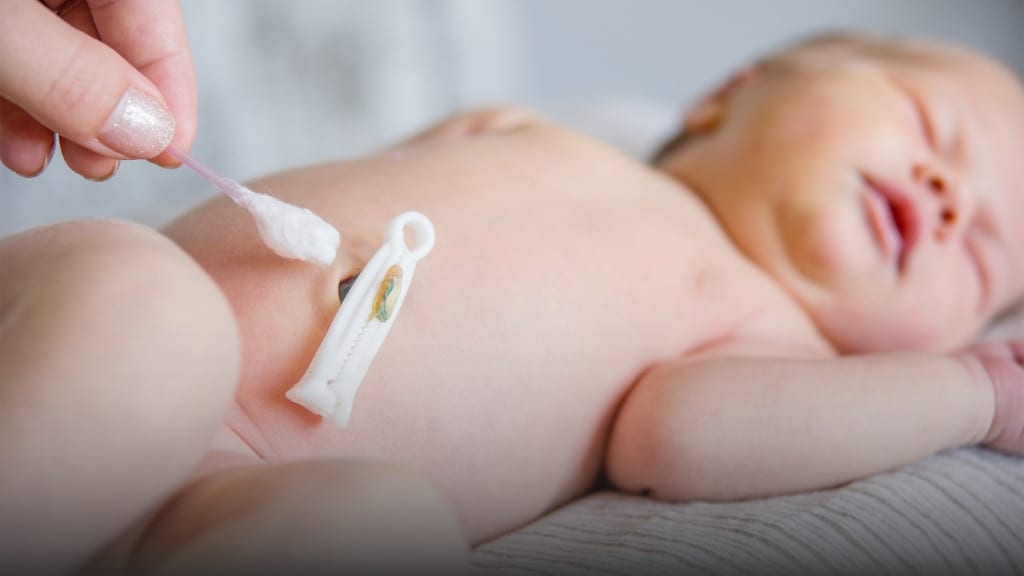
Table of Contents
Having that little human you nurtured for 9 months is a miracle come true. The one thing that new mothers may not think of is caring for the umbilical cord in a newborn. The umbilical cord is severed when your baby is born, leaving behind a stump. 5 to 15 days later, the stump will dry and fall off. That’s how it usually happens.
Let’s read more about umbilical cords before we get into their care instructions!
What is an Umbilical Cord?
During those 9 months of carrying your little human, the umbilical cord serves as a lifeline for both of you. Nutrients and oxygen-rich blood reach your baby’s tiny system while the waste is carried away through the cord. The umbilical cord has two arteries and one vein that connects your baby to your placenta.
Your child no longer requires the umbilical cord after birth. A short piece of the umbilical cord known as a stump will be left attached to your baby’s belly button when your medical health provider cuts the cord. Within a few weeks of birth, the stump will naturally dry out and fall off on its own.
What Does an Umbilical Cord Look Like?
The umbilical cord appears to be a spongy, flexible tube-like structure. The cord is surrounded by a jelly-like substance. Your midwife or doctor will cut the cord after clamping it, leaving behind an umbilicus (stump). The stump begins to dry out and fall off between one and three weeks later. Before falling off, the dried stump shrinks and changes color from yellowish-green to brown to black.
Umbilical Cord Care: How Do You Care for The Umbilical Cord Stump?
As we said, the umbilical cord is cut at birth and the rest falls off a few days later. But that’s not the end because the fallen stump leaves an open wound. Parents need to care for it to help it heal.
Here are some methods of umbilical cord care:
- You may use only gauze and water to clean the stump.
- Also, give the rest of your baby a sponge and a bath.
- Wait until the stump has fallen off before putting your baby in a tub of water.
- Allow the stump to naturally fall off. Even if it’s only hanging on by a thread, don’t try to pull it off.
Signs of an Infected Umbilical Stump
Examine the umbilical cord stump for signs of infection. This is quite rare but you must still keep an eye out for it as the infection has a high rate of spreading to other parts of the body. These are indicators of local infection at the stump:
- Redness, swelling, or tenderness of the skin around the stump.
- The skin will also smell bad.
- You may also notice a yellowish discharge from the stump.
The infection is even more serious if
- The cord stump is removed too quickly
- It may begin actively bleeding every time you wipe the area
- Inadequate feeding
- Fever of 100.4°F (38°C) or higher
- Lethargy
- Sluggishness
- Lack of muscle tone
Call your baby’s doctor right away if the cord stump continues to bleed and your baby is down with any of the above symptoms.
Complications of the Umbilical Cord
Although they are uncommon, the stump of the umbilical cord is linked to the following health problems:
Omphalitis
This is when the umbilical cord’s stump and surrounding area become infected. Tenderness, irritability, bleeding or fluid from the navel, fever, and other signs and symptoms are all possible. This condition requires antibiotic treatment.
Umbilical Hernia
A portion of the baby’s intestine protrudes through the muscles near the belly button. This condition is called an umbilical hernia. By age 2, it usually gets better on its own and is rarely serious.
Granuloma
A granuloma, a pink scar tissue, may develop on the cord in some instances rather than completely drying out. The granuloma drains a fluid with a light yellow color. Most of the time, this will go away in about a week. Call your baby’s provider if it does not.
Umbilical Cord Care: What Parents Should and Shouldn't Do?
A newborn’s umbilical cord stump will usually fall off about two weeks after birth. In the meantime, make sure you treat the stump gently. Here are a few umbilical cord tips:
- After every diaper change, most people typically swab the stump with rubbing alcohol to keep it dry. According to research, alcohol may eradicate bacteria that aid in the drying and separation of the cord. Instead, what parents must do is expose the stump to air and make sure the diaper is folded away from the stump.
- Sponge baths can help keep the baby clean yet dry. This way you don’t use too much water to wet the stump. Here’s more information on how to bathe a newborn.
- Refrain from pulling the stump off yourself by letting it fall off on its own.
The Bottom Line: Symptoms of an Issue With Newborn Umbilical Cord Care
A small amount of blood near the stump is common during the healing process. The stump may bleed a tiny bit when it falls off, just like it happens with a scab. However, if the umbilical stump area oozes pus, the surrounding skin becomes red and swollen, or the area develops a pink, moist bump, contact your baby’s healthcare provider because these signs could indicate an infection.
They will suggest medical treatment to contain the infection. You should also take your baby to a doctor if the umbilical stump doesn’t fall off 3 weeks after birth This could be a sign of a deeper issue, like an infection or disorder of the immune system.
Meanwhile, cherish these moments because they grow up real quick!









